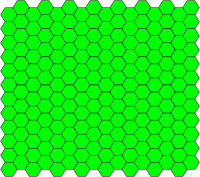Tilings of regular polygons

Have you ever seen a puzzle where you have to fit different shapes together to make a picture? That's what tiling is like, but instead of making a picture, we use regular polygons like squares, triangles or hexagons to fill up a whole area without leaving any space in between.
Now, let's talk about regular polygons. These are special shapes with equal sides and angles, like a square or a triangle that looks the same on both sides. When we tile regular polygons, we place them next to each other, following a certain pattern, so that they fit perfectly without overlapping or leaving gaps.
For example, if we have a square, we can add more squares next to it in a way that will cover the whole area without leaving any spaces. We can also use a pattern of squares and triangles to fill up the space, or even just triangles if we're feeling adventurous.
Sometimes we can tile regular polygons in more than one way, which means we have different patterns we can use. For instance, if we look at a hexagon, we can make a pattern using only hexagons, but we could also use triangles and squares to fill up the same space.
Tilings of regular polygons can be found in many places, from ancient mosaics to modern art. It's a fun and fascinating way to use math to create beautiful patterns and shapes.
Now, let's talk about regular polygons. These are special shapes with equal sides and angles, like a square or a triangle that looks the same on both sides. When we tile regular polygons, we place them next to each other, following a certain pattern, so that they fit perfectly without overlapping or leaving gaps.
For example, if we have a square, we can add more squares next to it in a way that will cover the whole area without leaving any spaces. We can also use a pattern of squares and triangles to fill up the space, or even just triangles if we're feeling adventurous.
Sometimes we can tile regular polygons in more than one way, which means we have different patterns we can use. For instance, if we look at a hexagon, we can make a pattern using only hexagons, but we could also use triangles and squares to fill up the same space.
Tilings of regular polygons can be found in many places, from ancient mosaics to modern art. It's a fun and fascinating way to use math to create beautiful patterns and shapes.
Related topics others have asked about:
